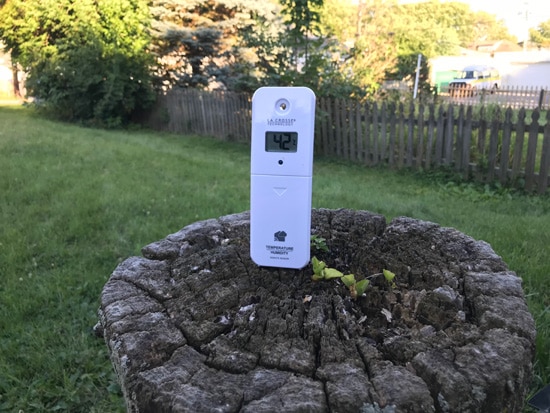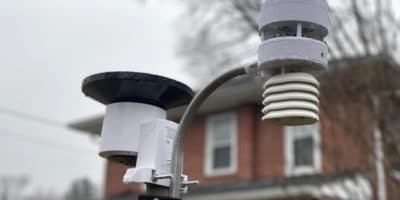For some of us, a professional home weather station is overkill. Many of us are just curious as to what the conditions outside are before we venture out each day. For these people, we recommend a good indoor outdoor thermometer, and La Crosse Technology’s V10-TH fits that bill.
While this thermometer operates just fine as a standalone unit, we strongly recommend that you take full advantage of the V10-TH's WiFi capabilities. When you connect the thermometer to WiFi, you gain access to live NWS (National Weather Service) forecasts and information, and you'll have the ability to view your weather readings remotely via the La Crosse View mobile app. It also connects to the NIST (National Institute of Standards and Technology) which automatically sets your time and date.
Why do we think the La Crosse V10-TH is one of the top options for those looking for solid performance at an affordable price? Read on and find out.
Our team of editors independently research, test, and recommend the best products to help you navigate when shopping online. This post contains compensated links, and if you make a purchase using the links included, we may earn a commission. To learn more, read our disclaimer.
Pros
- Large, easy-to-read console
- Forecast data from the NWS
- Easy app-based setup
- La Crosse View app allows you to monitor data remotely and add additional sensors
Cons
- Station daily high/low isn’t clearly displayed when WiFi connected
- Not built for more demanding weather watchers
Our Verdict
The La Crosse Technology V10-TH is an excellent indoor outdoor thermometer that will give you an accurate snapshot of your local weather each day for a very affordable price. The internet connectivity which provides access to NWS data and remote monitoring through the La Crosse View smartphone app are handy features that give this thermometer the edge over its equally priced competitors.
Included Instruments
Display Console
The V10-TH sports a large display console which measures in at 7.8 inches in height, and 6.4 inches wide. The display elements themselves are quite large, with indoor and outdoor information across the top right, NWS forecast information on the top left, and time, date, and textual information across the bottom.

The display has five levels of brightness (we found brighter settings might be too bright at night or in dark rooms though) and foliage in the forecast area changes with the season (an entirely non-functional feature, but a nice little touch). Trend arrows visually inform you of whether temperature or humidity is rising or falling, and battery level indicators let you know when it’s time to change the batteries.
Setup of the unit is relatively easy if you choose the WiFi connectivity option, as the entire process is completed through the app. You’ll need to keep two things in mind, however (1) your WiFi network strength, and (2) keeping the outdoor thermometer/hygrometer sensor within the range of the console.

In either case, you should have no problem here as the sensor itself has an impressive 400ft range. We had no issues here ourselves.
La Crosse View App
Most budget indoor/outdoor thermometers don’t usually include smartphone app connectivity. So, we must commend La Crosse Technology for enabling the V10-TH to work with their View app. The La Crosse View app is available for both iOS and Android. The same app is also used for La Crosse’s more full-featured home weather stations. Below are some screenshots of the app's interface.



The primary functions of this app include the ability to monitor your station’s readings over the internet and share them with friends, view historical data, and set alerts and set up the various NWS information that will cycle across the bottom of the display.
As we’ve mentioned already, you’ll complete the setup process for the V10-TH through the app, which we’d recommend as the non-WiFi setup can be a little tedious. All you need to do is install the batteries, place the sensor and console in your desired location, and then open the app. Then you have to scan a barcode on the back of the device and enter your WiFi network and password information, and in about one or two minutes the station connects.
Make sure that you’re connected to 2.4GHz WiFi and not 5GHz! The V10-TH supports 2.4GHz only, and if you attempt the setup while your device is connected to a 5GHz network, it will fail. We also recommend naming your console and your sensor differently in the app, such as their location, so you know which is which (you can also change the background picture of the sensor data to show their location if you’d like).
The console also has a feature called Data Stream, which can show various NWS data, including wind, snow, and sky conditions, and the probability of thunderstorms, hail or tornados. You can even program it to show custom personal messages.
We found the app pretty straightforward overall, if not a little on the barebones side. However, for what it does, the app works sufficiently well and is bug-free, which is something we find aggravating with a lot of low-cost weather instruments with internet connectivity.
What We Really Liked
The ability of the station to pull forecast data from the NWS rather than using an internal barometer to forecast future conditions is a definite plus. While many station manufacturers claim your station “learns” over time, sometimes using barometric pressure changes to make forecasts isn’t very accurate.
NWS forecast data also allows the device to display temperature and precipitation forecasts too, which we think is overall much more useful than merely using icons.
Accuracy is also in an acceptable range for digital thermometers, but not as precise as the more expensive personal weather stations.
What We Didn’t Like
Surprisingly enough, the NWS connectivity again. Here’s why: when you have WiFi connectivity enabled, the high and low data displayed on the console screen is pulled from the NWS, and not your station (you can find these in the app, however). There is a way to view overall high/low record data by holding down the “TEMP” button, but it doesn’t automatically reset daily (however, we will note that non-connected stations will see their own data instead).
Are There Better Alternatives?
Not really. In this space, there is a wide disparity in quality between digital thermometers, mainly because there are so many options. Most of the ones you see in department stores are of considerably lower sensor quality, which will result in less accurate readings. The V10-TH is one of the best that we’ve had the opportunity to test so far.
If you would like to see some more high-quality indoor outdoor thermometers, we suggest that you take a look at our indoor outdoor thermometer guide. If you’re looking for better accuracy and a whole lot more functions for a reasonable price, we’d suggest splurging on the Ambient Weather WS-2902C weather station instead. We rated it the best home weather station for the price.
Should You Buy It?
Among indoor outdoor thermometers, the V10-TH gets our endorsement. While it has its quirks, none of them are deal breakers. The price, which comes in considerably below most of the top home weather stations makes this an attractive option for those just looking for a way to get a quick look at the weather before heading out for the day.
La Crosse Technology V10-TH Indoor Outdoor Thermometer Review Summary
Accuracy
Features
Ease of Installation
Ease of Connecting to the Internet
Value for Money
Summary
Some users don’t need a full-featured weather station to keep an eye on the weather. The La Crosse Technology V10-TH indoor outdoor thermometer is a reasonably priced alternative to the more expensive home weather stations. Although it has its quirks, we especially liked the NWS forecast based weather icons, which are much more accurate than the barometric pressure trend method nearly every other “forecasting” weather station uses.
4.1





